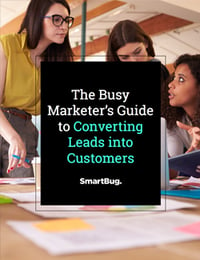
Leads vs. Prospects: How You Should Treat Them Differently
June 17, 2019
By Sarah Mead
Demand generation is a powerful element of any sales and marketing strategy, especially an inbound strategy. However, leads are just one piece of the puzzle. And although the inbound methodology is built upon the idea of attracting, converting, closing, and delighting qualified contacts, this methodology is only effective when communication with prospective clients is aligned with the Buyer’s Journey.
One major piece of building your sales and marketing strategy is considering how you will communicate with people at each stage of the buying process. This means determining how you’ll approach communication with leads versus prospects.
Here’s where it gets fun: One common misconception in marketing is that the terms “lead” and “prospect” are interchangeable. They are, however, different and therefore your communication with them should be adjusted accordingly.
The Difference Between Leads and Prospects
The main differentiator between leads and prospects is the level of engagement between the contact and your brand.
Leads have likely only had one-way communication with your brand and are at an awareness level in their Buyer’s Journey—meaning they have not shown an indication that they’re intending to buy.
Prospects, on the other hand, are more qualified and have demonstrated some interest in your product or service. As it pertains to the Buyer’s Journey, they are likely further down the pipeline and more closely aligned with the consideration stage.
Here is a comparison so you can more clearly see the differences between leads and prospects:
|
Leads |
Prospects |
|
|
Type of Communication |
One-way communication |
Two-way communication |
|
Stage of Buyer’s Journey |
Awareness |
Consideration |
|
Possible |
|
|
|
Goal of Your Communication |
Convert to a prospect through brand awareness |
Convert to a sales opportunity by further nurturing the relationship |

How to Approach Communication with Leads: Lead Nurturing
The goal of your communication with leads should be to convert them into prospects who can be further nurtured through the sales funnel. This communication strategy shouldn’t begin with a sales pitch or a hard sell of your brand. Remember that the lead hasn’t given any indication that they are ready to buy and should be treated accordingly.
Consider how this lead came to you in the first place and what information you have about them so far. Let’s say a lead downloaded an awareness stage e-book on your website. Are there other resources you can share with this lead that align with the topic of the e-book? Begin to build a communication strategy with multiple touchpoints based on the lead’s interests and what they will find most helpful.
Once you’ve built in helpful touchpoints with the lead, you’ll want to consider the type of content you can share that will move the lead to a prospect stage. Look at behavioral and persona data you have in order to inform this strategy.
How to Approach Communication with Prospects: Sales Prospecting
Once leads become prospects, your goal should be to convert them into sales opportunities. Now that these contacts have been moved along in the pipeline, you can shift your approach to inject more promotional content, while still being helpful.
The key to effective communication with your prospects is confirming they are qualified to be a potential customer and then aligning their known challenges with your solutions.
Remember that e-book they downloaded? What problem were they looking to solve when they found that content, and how can your product or service help meet those needs?
When building out your touchpoints, consider how the prospect has engaged with your content and your organization to date. Do they value phone calls and face-to-face time or do they prefer email communication? Are they engaging with videos or your long-form blog posts? Use data to inform how you engage with prospects so they stay engaged and keep moving through the pipeline.
As with any strong marketing strategy, it is crucial to communicate with people at the right place and right time. There is a much greater likelihood that your team will improve conversion rates when marketing and sales are aligned and have an intentional approach to communication through every stage of the pipeline.

About the author
Sarah Mead is the Associate VP of Client Services at SmartBug and plays a key role in building and maintaining excellent client experiences that result in happy customers. She is tirelessly passionate about leading her team members to achieve personal growth and success. Outside of work, you'll find Sarah teaching yoga, enjoying the outdoors, taking care of her plant collection, traveling far and wide, and grooving to the latest independent radio hits. Read more articles by Sarah Mead.






